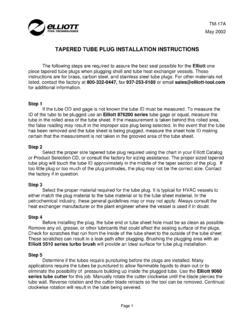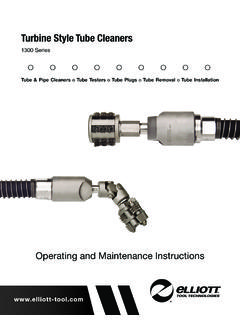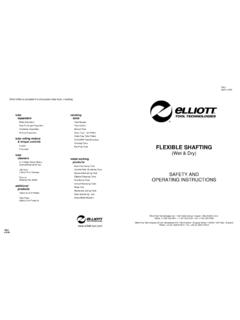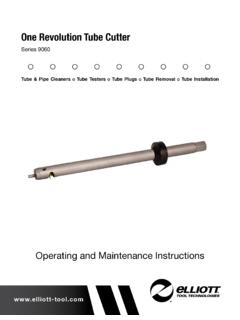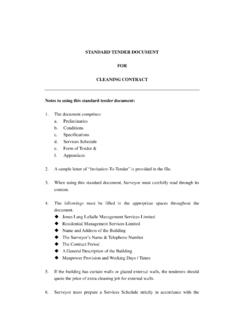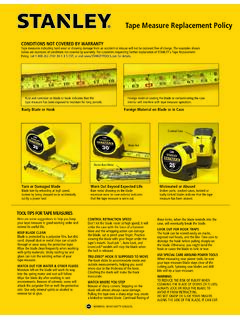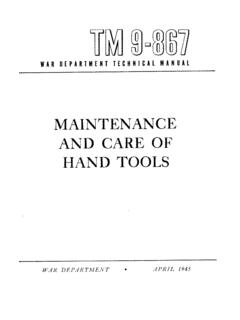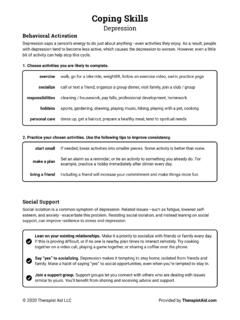Transcription of TM-6 Basic Principles of Tube Expanding - Elliott Tool
1 Basic Principles of Tube ExpandingTube Expanding is the art of reducing a tube wall by compressing the of the tube against a fixed container ..such as rolling tubes into tube sheets, drums, ferrules or flanges. To assure a proper tube joint, the tube wall mustbe reduced by a predetermined percentage. The following chart can be used for determining the correct tube chart shows a typical 3/4 16 gauge tube. Before rolling this tube you would find the proper rolling dimensionas First determine the tube hole Then determine the tube outside Subtract the tube outside diameter from the tubehole With an Elliott Tube Gauge, determine the insidediameter of the tube before By adding the dimension found in D to theclearance between the tube and the tube hole.
2 You will then know the tube s inside diameter atmetal to metal Roll the tube to what you feel is a good tube example was rolled and then the of thetube was checked with an Elliott Tube By subtracting E from the rolled diameter youdetermine the actual amount of expansion (tubewall reduction) on the inside diameter of your can be converted to a % of wall reduction bydividing the actual wall thickness ( B minus D ).130 into the amount of roll . can use this chart to your advantage by predetermining both the % of wall reduction required and the actualinside diameter which should be rolled. After the completion of E you realize any additional increase of the insidediameter of the tube will result in actual wall reduction.
3 Since the amount of wall reduction greatly determines thequality of the tube joint, you should arrive at the % required for your application prior to tube subtracting the tube inside diameter D from B , you determine actual wall thickness. This example wouldtherefore be .130 . If you then take the 7% wall reduction times the wall thickness, you arrive at .0091 . ( G ) to .627 ( E ) we get F the inside diameter of the tube after rolling (.636 ). Tube Test Number123456 ATube Sheet Hole Outside (A Minus B).007 DTube Inside Inside Diameter When is Reached (D Plus C)FTube Inside Diameter After Amount of Roll on Diameter (F Minus E).
4 009 Note:1) Take all measurements in thousandsCustomer:_____2) Take A in middle of area to be rolledLocation:_____3) Take B , D and F in same position as No. 2 Unit:_____4) Take both horizontal and vertical diameters asTube Alloy: _____tubes may be out of round show mean diameterDate:_____Test Chart For Determining Proper Amount Of Tube ExpansionTM-6 02-10-04 Here is a summary of important factors in rolling certain alloys: When rolling 3003 or 4004 Aluminum you should notreduce the walls over 5%. When rolling 6061-T Aluminum, which is one of the most popular materials used in aircraftfittings, you can reduce the wall 10 to 12% for a mechanical is a tube process called Alonizing.
5 It is stated that Alonized steel combines the heat and corrosion resistantproperties of the iron aluminum alloy with the strength and rigidity of steel. When rolling this tubing it is extremelyimportant to lubricate each tube end and make certain that the tube expanders are kept clean. Remove all particles ofthe tubing materials from the expanders to decrease tool fatigue. When rolling Alonized tubing, abrasive particles areremoved from the inside diameter of the tubing and gathered in the expander. It is recommended that two expandersbe used. One should be cleaned and lubricated while the other is being Brass is widely used in condensers. This material should be well lubricated.
6 The tube wall is reducedapproximately 7% to 8% for optimum tube joints. In general, only a 4% to 10% reduction in wall thickness isnecessary to produce a tight tube in a serrated hole. On the other hand, reduction in excess of 15% may causeleaking, splits or flaked Steel is used in almost every type of pressure vessel built today. Tube wall reduction should beapproximately 7% to 8%. Heavy lubrication is a must. If the tube is cracking or tooling shows excessive wear, tubehardness should be checked. Carbon Steel tubes should be 90 to 120 Brinnel hardness for rolling. It is possible toroll tubes up to 150 Brinnel; however, flaking and cracking are more likely to occur as the tube hardness rolling Copper and Cupro Nickel, consider approximately 8 - 10% wall reduction to be a proper tube , since it is one of the softer tubes used in pressure vessels, can be easily rolled.
7 Use plenty of lubricationbecause copper has an abrasive action on tube rolling Stainless Steel and Titanium, approximately 4 to 5% wall reduction is sufficient to produce a tight tube ina serrated hole. When rolling these alloys the entire wall reduction should be done quickly. These materials have agreater tendency to work harden; therefore, minimal or no rerolling should done. Motor speeds should be 400 to rolling Titanium, it is recommended to use an expander with four rolls or more. This will decrease diaphragm ofa thin wall and help eliminate tube end cracking. There are, however, exceptions to the above discussion of alloys has been related to those used in pressure vessels such as boilers, heat exchangers, andcondensers.
8 These factors would be approximately the same in a mechanical joint for industrial use. However, agreater percent of wall reduction is usually considered when making a mechanical joint. Higher quality tubes areused in industrial Causes of Tube LeaksTube rolling leakage is usually caused by one of the following: under-rolling, over-rolling, improper preparation oftube sheets and differential thermal expansion. Improper expansion can lead to serious difficulties for both themanufacturer and the repair service ExpandersBasic Principles of Tube ExpandingThis technique is an excellent way to set torque rolling devices. Once you have arrived at the rolled dimension for four orfive tubes , you can roll them and very simply determine if more or less wall reduction is required.
9 Knowing how todetermine wall reduction is important; however it is equally important to know the characteristics of the popular tubingmaterials. We should know the proper wall reduction which would apply to each metal. A simple rule of thumb is theharder the material, the less wall reduction is required to obtain a tube joint. For example, you can assign these asapproximate percentages of wall reduction when rolling pressure vessels:Tubing Material:Copper & Cupro Nickel8 - 10%Steel, Carbon Steel & Admiralty Brass7 - 8%Stainless Steel & Titanium4 - 5%These materials and percentages can be your guideline to rolling tubes of like also causes distortion in tube sheets or drums, such as egg-shaped holes.
10 It will also cause diametricalexpansion which is the overall increase of a tube sheet or drum. Over-rolling has been known to cause a tube sheet tobow or warp to the point where the standard length tube could not be used in the vessel until the bowing or warpage isreturned to normal. This is usually corrected by placing stay rods in the vessel and pulling the tube sheets back to theiroriginal Preparation of Tube HolesImproper preparation of tube holes is another major cause in tube leakage. If the tube sheet or drum is gouged, it isextremely hard to expand the tube to fill these gouges or tears without over-rolling. The smoother the tube seat or tubehole the easier it is to roll an optimum tube joint.
